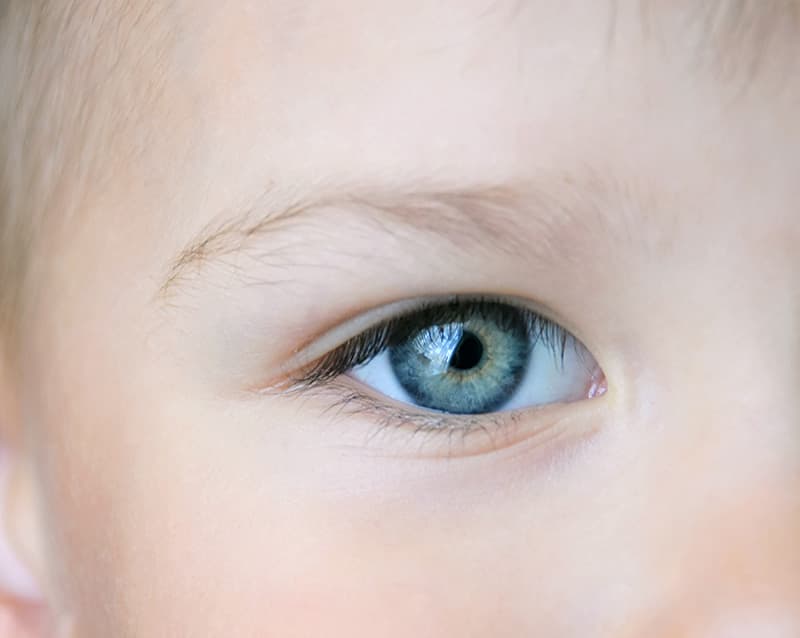Pediatric Eye Care
When children have vision problems or eye conditions, it requires a special type of care. Dr. Lucas Bonafede, the pediatric ophthalmologist at Fraser Eye Care in metro Detroit, is greatly experienced in the diagnosis and treatment of pediatric eye conditions. He is also an expert at working with our smallest patients in a way that helps them feel comfortable. Dr. Bonafede’s gentle touch and use of advanced technology allow us to provide the highest quality of comprehensive eye care for children.
Pediatric Eye Conditions
At Fraser Eye Care, Dr. Bonafede is experienced in treating a wide range of pediatric eye conditions, including amblyopia, strabismus, refractive errors, blocked tear ducts, pediatric cataracts, pediatric glaucoma, droopy eyelids, and more.
Amblyopia
Often referred to as “lazy eye,” amblyopia is an abnormality in the development of sight that leads to decreased vision in one or both eyes. Amblyopia has many potential causes, including imbalances in the muscles responsible for eye position, differences in the focus between both eyes, or obstructions to normal vision such as cataracts or a droopy eyelid.1 As the brain gradually adjusts to relying more heavily on vision from the better seeing eye, vision in the weaker eye often declines further.
Amblyopia is the leading cause of vision loss in children. The most noticeable symptom of this condition is often one eye that wanders inward or outward. Additional symptoms may include:
- Poor depth perception
- Shutting one eye
- Squinting
- Tilting the head
Amblyopia is more common in children who had a low birth weight, were born prematurely, have developmental delays, or have a family history of the condition.2
Treatment for amblyopia is most effective when it begins early in a child’s life, and may include:
- Wearing a patch over the stronger eye
- Corrective eyewear
- Eyedrops
- Surgery
Strabismus
Strabismus, a condition that causes the eyes to cross, is common in children. Strabismus does not only refer to crossed eyes, but any situation where the eyes do not line up properly. For example, one eye may point to the left, right, up, or down, while the other eye looks straight ahead.
In most patients, the cause of strabismus is a problem with the way the brain controls the eye and surrounding muscles. In some cases, strabismus is caused by problems with the muscles that control the eye.
There are a number of types of strabismus:
- Esotropia: the eyes turn inward
- Exotropia: the eyes turn outward
- Hypertropia: vertical misalignment of the eyes
- Cyclotropia: the eye is twisted clockwise or counter-clockwise
Because the eyes are aligned in different directions, strabismus can cause double vision, problems with depth perception, and other vision problems.
When strabismus goes untreated, it can result in amblyopia or a “lazy eye.” This may cause permanent vision loss. We offer several treatments for strabismus. Prescription eyewear and eye exercises can be helpful for many patients, while surgery may be required in some cases.3
Failed Vision Screening
Patients often get referred to the ophthalmologist following a failed vision screen from school or a pediatrician. Dr. Bonafede will examine the child to ensure that an underlying condition other than a refractive error is not causing his or her vision problems, then recommend appropriate treatment when necessary.

Refractive Errors
A refractive error is a problem with the way the eye focuses (or refracts) light, leading to blurry or unclear vision. There are three refractive errors:
- Myopia (Nearsightedness): In people who have myopia, the eye is longer than normal or the cornea is steeper than normal. This causes light to be focused in front of the retina, which makes it difficult to see distant objects clearly. Myopia is often diagnosed when children are 8-12 years old, and often runs in families.4
- Hyperopia (Farsightedness): When a person is farsighted, the eye is shorter than normal or the cornea is flatter than normal. This causes light to be focused behind the retina, making objects appear blurry. In fact, most children are farsighted, but their eyes adjust to allow them to see both near and distant objects clearly. Hyperopia tends to decrease as children get older.5
- Astigmatism: Astigmatism is a problem with the curvature of the cornea or lens of the eye, and can cause both near and distance vision to be blurry. Like other refractive errors, astigmatism is often inherited.6
In many cases, children don’t complain about blurry vision, so it is important for your child to undergo screening eye exams.
The best way to treat refractive errors in children is to fit them with corrective eyewear. Our team can properly diagnose your child’s refractive error and recommend the right glasses to help him or her see clearly.
Sometimes, nearsightedness can start at an earlier age, progress faster, or become more significant than a simple issue of needing glasses. High levels of myopia are becoming more common across the world. Importantly, progressive nearsightedness (myopia) can lead to an increased risk for retinal disease and glaucoma. There are several treatments that can be utilized to help prevent the progression of myopia, including medicated eye drops and specialty contact lenses.
Disorders of the Nasolacrimal System and Blocked Tear Ducts
The nasolacrimal duct, commonly known as the tear duct, is where tears are carried from the eye to the nasal cavity.
The most common problem affecting the nasolacrimal system is a nasolacrimal duct obstruction, or a blocked tear duct. Roughly 6-20% of babies are born with blocked tear ducts (nasolacrimal duct obstruction).7 This condition may not be immediately noticeable, because most babies don’t produce tears until they are a few weeks old.
Symptoms of blocked tear ducts in children may include:
- Tears that pool in the corners of a baby’s eye
- Tears that drain down a baby’s face
- Yellow discharge in a baby’s eye
- Excessive mucus in a baby’s eye
- Red skin around a baby’s eye, caused by rubbing
- Recurrent eye infections
Most blocked tear ducts in children heal on their own. However, if this is not the case and blocked tear ducts are left untreated, an infection may result. Conservative treatments, like eye drops, antibiotics, and massage, help clear blocked tear ducts in over 90% of cases. If these methods don’t work, Dr. Bonafede may recommend a procedure to clear the blockage. This may include probing and flushing of the tear duct, dilation using a balloon catheter, or stenting of the tear duct.
Dr. Bonafede is experienced in treating a range of nasolacrimal system disorders. He can properly diagnose your child’s condition and provide necessary treatment.
Dacryoadenitis
Dacryoadenitis is inflammation of the lacrimal gland, which releases tears to cleanse, protect, and lubricate the eye surface. When the lacrimal gland becomes inflamed, it can cause symptoms such as:
- Discomfort or pain
- Excessive tearing
- Inflammation or swelling of the eyelid
- Redness or tenderness of the eyelid
- Pain and inflammation of the lymph nodes in front of the ear
In some patients, dacryoadenitis is chronic and caused by underlying inflammatory disorders like sarcoidosis. In others, the condition is acute and may be caused by a viral or bacterial infection.
Dr. Bonafede will conduct a thorough examination to determine the cause of the lacrimal gland inflammation, then treat it accordingly. Treatment may include rest and anti-inflammatory medications for viral dacryoadenitis, antibiotics for bacterial dacryoadenitis, or treatment of the underlying disease behind the condition.8
Droopy Eyelids
Droopy eyelids, or ptosis, are caused by a weakness in the muscle that raises the eyelid. Most commonly, children have congenital ptosis (they are born with it), but in some cases, weakness of the eyelid muscle can happen later in childhood.
In mild cases, droopy eyelids in children don’t impair their vision and do not require treatment. However, some children with ptosis may develop astigmatism, a “chin up” position they adapt to see beneath their eyelids, or abnormal visual development causing a “lazy eye” (amblyopia).10 In some cases, a droopy eyelid can be associated with an underlying condition. It is very important to have an evaluation if there is a new droopy eyelid to rule out a neurological cause for the ptosis.
For children with ptosis severe enough to affect their vision or eye health, surgical treatment may be recommended.

Conjunctivitis
Conjunctivitis, commonly known as “pink eye,” is inflammation of the outer lining of the eye or the conjunctiva. Healthy conjunctiva is white, and inflammation causes the conjunctiva to appear red or pink. It can also be associated with tearing and discharge from the affected eye.
Conjunctivitis is a common condition that affects people of all ages but is seen frequently in children. It is frequently caused by bacteria or viruses, though it can also be caused by chemicals or an allergic reaction.
Treatment for bacterial conjunctivitis often consists of anti-bacterial eye drops or ointments, and allergic conjunctivitis can be treated with allergy eye drops. Viral conjunctivitis is usually self limited and is treated with lubrication and cool compresses. Conjunctivitis can be uncomfortable, but in most cases does not cause permanent damage to the eye. However, other conditions may first appear as eye redness, so it is important to have Dr. Bonafede examine your child’s eyes to confirm the diagnosis and provide treatment.9
Uveitis
Uveitis is inflammation of the middle layer of the eye, called the uvea. The uvea contains blood vessels that help to nourish the eye, and inflammation can affect one or each of its three parts: the front (anterior uveitis), the middle (intermediate uveitis), or the back (posterior uveitis).11
Uveitis may be caused by infections or inflammatory conditions like Juvenile Idiopathic Arthritis, sarcoidosis, or HLA-B27 related conditions such as ankylosing spondylitis or inflammatory bowel disease. In many cases, an underlying cause is not found. Symptoms may include:
- Eye redness
- Eye soreness
- Sensitivity to light
- Blurred vision
- Seeing “floaters”
If not diagnosed and treated properly, uveitis can cause permanent damage to the eye and vision. Uveitis can be complicated by damage to the optic nerve, retinal scarring or detachment, cataracts, and glaucoma. Treatment for uveitis may include anti-inflammatory medications, dilating eye drops, antibacterial or antiviral medications, or immunosuppressive drugs.12
Pediatric Cataracts
Cataracts, or clouding of the natural lens of the eye, are a common condition in aging eyes. However, in some cases, children are born with or develop cataracts in one or both eyes. In other cases, pediatric cataracts may be caused by an eye injury. Congenital pediatric cataracts are often diagnosed before newborn babies even leave the hospital or during well-baby checkups with a pediatrician. In some cases, parents notice a cloudy appearance in the baby’s eyes.
As with adult cataracts, pediatric cataracts can impair vision and even cause vision loss. The effect of cataracts can often not be fully reversed due to the development of lazy eye (amblyopia) or due to an underlying eye issue. Cataracts may be treated with surgery, during which the surgeon removes the cloudy lens of the eye and, depending on the age of the child, replaces it with an artificial intraocular lens.13
Pediatric Glaucoma
Glaucoma is an eye condition that is most frequently associated with older patients. In children, glaucoma is usually congenital (the child is born with it), secondary to an underlying condition, or following a surgery or trauma. Glaucoma causes damage to the optic nerve and is typically associated with high pressure inside of the eye.
Symptoms of pediatric glaucoma may include:
- Excessive tearing
- Sensitivity to light
- Eyes that look cloudy
- A dull appearance to the cornea
Treatment for pediatric glaucoma consists of lowering the pressure in the eye through medication or surgery, or both.14

Retinoblastoma
Retinoblastoma is a malignant eye tumor that usually occurs in children less than 5 years old. This tumor grows from the retina, at the back of the eye, and can cause symptoms such as:
- A white appearance to the pupil at the center of the eye when light is shown, such as in a flash photograph
- Vision problems
- Eyes that appear to look in different directions
- Eye misalignment (crossed eyes)
- Redness
- Swelling
Retinoblastoma may be inherited, but it is not necessary to have a family history of retinoblastoma to develop this condition. Children diagnosed with retinoblastoma are at a higher risk for developing other cancers throughout their lives.15
Treatment for retinoblastoma has advanced significantly in recent decades, with a current cure rate of near 95% if noted and managed early. Treatment may include chemotherapy, radiation therapy, laser therapy, cryotherapy, or surgery.16
Contact Fraser Eye Care in Detroit
If your child is experiencing vision problems or symptoms associated with eye conditions, early diagnosis and treatment are the best way to protect the health of their eyes. To schedule a consultation with pediatric ophthalmologist Dr. Lucas Bonafede, please contact Fraser Eye Care today.
Ready to Schedule an Appointment?
Book Online Sources
Sources
1Mayo Clinic. Lazy Eye (amblyopia). Available: https://www.mayoclinic.org/diseases-conditions/lazy-eye/symptoms-causes/syc-20352391. Accessed August 30 ,2021.
2 National Eye Institute. Amblyopia. Available: https://www.nei.nih.gov/learn-about-eye-health/eye-conditions-and-diseases/amblyopia-lazy-eye. Accessed August 30, 2021.
3 American Association for Pediatric Ophthalmology & Strabismus. Strabismus. Available: https://aapos.org/glossary/strabismus. Accessed August 17, 2021.
4 American Academy of Ophthalmology. Nearsightedness: What is Myopia? Available: https://www.aao.org/eye-health/diseases/myopia-nearsightedness. Accessed August 30, 2021.
5 American Academy of Ophthalmology. Farsightedness: What is Hyperopia? Available: https://www.aao.org/eye-health/diseases/hyperopia-farsightedness-symptoms. Accessed August 30, 2021.
6 American Academy of Ophthalmology. What is Astigmatism? Available: https://www.aao.org/eye-health/diseases/what-is-astigmatism. Accessed August 30, 2021.
7 Perez Y, Patel BC, Mendez MD. Nasolacrimal Duct Obstruction. [Updated 2021 Aug 11]. In: StatPearls [Internet]. Treasure Island (FL): StatPearls Publishing; 2021 Jan-. Available from: https://www.ncbi.nlm.nih.gov/books/NBK532873/. Accessed November 16, 2021.
8 American Academy of OphthalmologyI a. Dacryoadenitis. Available: https://eyewiki.org/Dacryoadenitis. Accessed September 13, 2021.
9 American Association for Pediatric Ophthalmology and Strabismus. Conjunctivitis. Available: https://aapos.org/glossary/conjunctivitis. Accessed August 30, 2021.
10 American Association for Pediatric Ophthalmology & Strabismus. Ptosis. Available: https://aapos.org/glossary/ptosis. Accessed August 178, 2021.
11 American Academy of Ophthalmology. What is Uveitis? Available: https://www.aao.org/eye-health/diseases/what-is-uveitis. Accessed August 30, 2021.
12 Mayo Clinic. Uveitis. Available: https://www.mayoclinic.org/diseases-conditions/uveitis/diagnosis-treatment/drc-20378739. Accessed August 30, 2021.
13 American Academy of Ophthalmology. Pediatric Cataracts. Available: https://www.aao.org/eye-health/diseases/what-are-pediatric-cataracts. Accessed August 17, 2021.
14 American Association for Pediatric Ophthalmology & Strabismus. Glaucoma for Children. Available: https://aapos.org/glossary/glaucoma-for-children. Accessed August 17, 2021.
15 Hopkins Medicine. Retinoblastoma. Available: https://www.hopkinsmedicine.org/kimmel_cancer_center/cancers_we_treat/pediatric_oncology/becoming_our_patient/cancer_types/retinoblastoma.html. Accessed August 30, 2021.
16 Mayo Clinic. Retinoblastoma. Available: https://www.mayoclinic.org/diseases-conditions/retinoblastoma/diagnosis-treatment/drc-20351013. Accessed August 30, 2021.
Dr. Lucas Bonafede has either authored or reviewed and approved this content.

